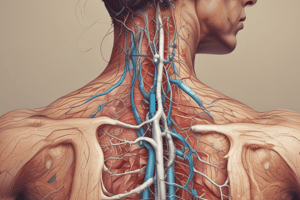Podcast
Questions and Answers
What is the primary purpose of sweat in the body's thermoregulatory mechanism?
What is the primary purpose of sweat in the body's thermoregulatory mechanism?
- To take heat away from the body through the latent heat of vaporization (correct)
- To remove waste products from the body
- To maintain blood pressure
- To regulate the body's pH level
What type of sweat glands are primarily responsible for thermoregulation?
What type of sweat glands are primarily responsible for thermoregulation?
- Apocrine sweat glands
- Sebaceous glands
- Sudoriferous glands
- Eccrine sweat glands (correct)
What is the composition of sweat?
What is the composition of sweat?
- Water and electrolytes only
- Hormones and enzymes only
- Proteins and carbohydrates only
- Water, sodium, chloride, and small amounts of urea, uric acid, glucose, and amino acids (correct)
What is the purpose of peripheral vasodilation in thermoregulation?
What is the purpose of peripheral vasodilation in thermoregulation?
What is the role of the kidneys in thermoregulation?
What is the role of the kidneys in thermoregulation?
Where are apocrine sweat glands primarily found?
Where are apocrine sweat glands primarily found?
Study Notes
• When the body gets too hot, peripheral vasodilation occurs first, and if that's not enough, the body produces sweat as a secondary thermoregulatory mechanism.
• Sweat glands are coiled tubes deep in the dermis, with a glandular component and a sweat gland duct, and are associated with small blood vessels.
• Sweat is formed from plasma in the glandular component and then moves up the sweat gland duct to the surface of the body, where it evaporates, taking heat away from the body through the latent heat of vaporization.
• As long as the body can sweat and the sweat can evaporate, it can maintain a physiological body temperature even in extreme environments.
• In hot environments, if the body can't sweat or the sweat can't evaporate, the body temperature can rise, leading to life-threatening hyperthermia.
• The thermoregulatory sweat glands are called eccrine sweat glands, and there are approximately 3-4 million of them all over the surface of the body.
• Eccrine sweat glands contain water, sodium, chloride, and small amounts of urea, uric acid, glucose, and amino acids, reflecting the composition of the plasma.
• Sweat glands are not homeostatic, meaning they don't regulate the amount of material lost in sweat to maintain the internal environment of the body; that's the job of the kidneys.
• There's another type of sweat gland called an apocrine sweat gland, which is larger and opens into hair follicles, primarily found in the axilla and groin area.
• Apocrine sweat glands are stimulated by hormonal changes at puberty and produce sweat throughout adult life.
• Apocrine sweat contains lipids and proteins, making it thicker, and does not smell initially, but bacteria on the surface of the body metabolize the lipids and proteins, producing waste products that give off a strong smell.
• The combination of apocrine sweat and bacterial action on the skin's surface can produce a characteristic smell, which some people believe may contain pheromones that can be attractive or recognizable.
Studying That Suits You
Use AI to generate personalized quizzes and flashcards to suit your learning preferences.
Description
Learn about the body's thermoregulatory mechanisms, including peripheral vasodilation and sweat production, and how they help maintain a physiological body temperature. Discover the structure and function of eccrine and apocrine sweat glands, and their roles in regulating body temperature.




